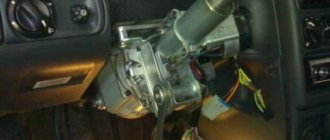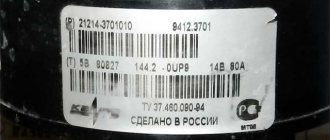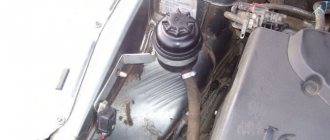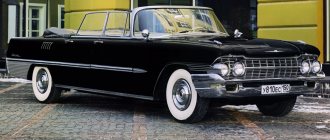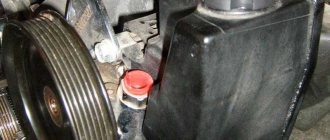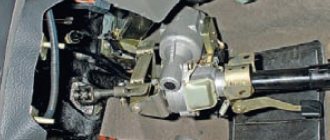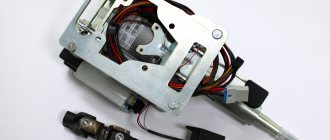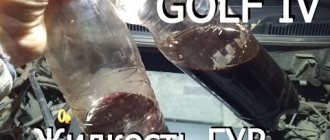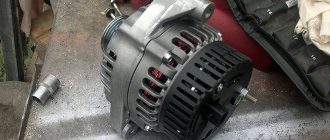Power steering did not appear on cars right away, because the very first cars (and some modern cheap models in the basic configuration like ZAZ Chance) did not particularly need this element due to low speeds, low weight, small contact patch with the road (the first the tires were quite narrow). However, the automotive industry, including the truck industry, developed, and in the 30s of the last century, pneumatic power steering appeared on mining dump trucks. A little later, this idea “migrated” in the form of a hydraulic system to passenger cars. In the USA, the first power steering appeared on the Chrysler Crown Imperial in 1951, and in Europe - in 1954 on the Citroen DS 19. Power steering on the Niva appeared decades later.
Fluid in Niva Chevrolet
At the moment, almost all modern car models are equipped with power steering. It allows you to simplify wheelbase control and make it easier. This is especially true for a car like the Chevrolet Niva, which belongs to the SUV class. The Niva's mass is one and a half tons, and in off-road conditions it is required that the wheels react sharply to turning the steering wheel. In such conditions, there is an increased load on the steering, which is fraught with breakdowns, which may result in a leak. If the level in the expansion tank drops at the slightest level, you must immediately add fluid to the Niva Chevrolet. You can do this yourself, without visiting a service station.
Also, the need to add fluid to the steering wheel on a Chevrolet Niva can be determined by its external condition. It is believed that the power steering is refilled once by the manufacturer and does not require replacement during further operation. But if there is damage to the steering rack, oil and dirt may enter the system. As a result, traces of contamination can be seen in the expansion tank. Also, power steering fluid, like all fractional mixtures, can form a sediment of components over time, which affects its quality and requires replacement. In practice, it is necessary to change it every six years, regardless of its condition, since the temperature difference between winter and summer negatively affects its condition.
Types of liquid used
The main types of liquids that are recommended for use in the Niva are Shell Donax and Ravenol Dextron II D. Previously, to determine what was filled at the factory, the markings “*” were applied to the tank to indicate Shell products and “R” for Ravenol. Recently, the manufacturer has been abandoning such labels, so it is necessary to identify the brand by color.
To replace, the bracket bolt is unscrewed. After which it becomes possible to remove the tank plug.
The tank can be removed from the bracket to drain the liquid into a specially prepared container. After this, you can loosen the clamp of a suitable hose to remove the tank.
To prevent liquid from flowing out, it is necessary to close the hole in the tank fitting, after which you need to lower the end of the hose to drain it into a container to drain the liquid. Then you need to start the engine and turn the steering wheel in different directions 3-4 times until it stops. The old fluid will gradually leave and new fluid will need to be added at the same time. The operation must be repeated until a new one begins to emerge from the outlet hose. The tank is installed in the reverse order. The fluid should be at the top level of the dipstick.
Bleeding the power steering system
To bleed the power steering system on a Niva, you need to set the steering wheel to the middle position and start the engine for a few seconds without turning the steering wheel. After this, you need to turn off the car and turn the steering wheel all the way in any direction.
Then the protective cap is removed from the special valve and, using a wrench, it is turned to bleed any remaining air from the system.
Then you need to turn the steering wheel in the other direction, leaving the air bleed valve open. An air plug and some liquid will come out of it, after which the valve must be closed. If necessary, the mixture is added to the power steering to the maximum mark. Then you need to start the engine and turn the wheel from side to side until it stops. This must be done until air bubbles stop escaping into the tank. If necessary, the mixture is topped up again to the required level.
expertniva.ru
Installing power steering, replacing hoses and power steering fluid for Chevrolet Niva (VAZ 2123)
The content of the article:
Replacing power steering fluid in a Chevrolet Niva (VAZ 2123)
Actually, having stopped by to specially adjust the headlights before the maintenance, the local master, who was starting his own business, decided to lure me to his place by opening the power steering reservoir cap and pleased me with a quick replacement, so the oil there was dark in color and smelled of burning. He asked for 1000 rubles for the work. Ha! Yes, I'm over a thousand... In short, we climbed onto the glorious Lacetti club www.lacetti-club.ru/vb_forum/index.php where I found a detailed description of the operation www.lacetti-club.ru/vb_fo...php?p=755031&postcount=72 But there was no photographs. But it will be easier to navigate using the pictures. Even in driving schools they study traffic rules from pictures. I decided to correct this misunderstanding. In general, I found some time and got to work. To replace, we will need the following tools: a medical syringe
Operating principle of the hydraulic control system
How does power steering work? Its main element is a pump, which, using a belt from the crankshaft, sucks in oil and pumps it into the distributor. The latter, in turn, monitors the force applied to the steering wheel and, using a torsion bar (follower device), helps turn the drive wheels. When moving in a straight line, the torsion bar does not twist, so the distributor channels are blocked and the oil drains back into the reservoir.
Power steering is most often useful when parking and turning, making the work of your hands three times easier. We can also say that the mechanism weakens the transmission of microshocks from the road surface to the steering. The mechanism is also useful in case of a sharp drop in tire pressure. The disadvantages of power steering include the fact that it interferes with “feeling the car”, so designers need to achieve a compromise between informativeness and tightness of the steering wheel.
Foreign manufacturers conduct a lot of research in order to make the hydraulic booster light at low speeds and elastic at high speeds. To do this, German hydraulic boosters from ZF are equipped with pressure modulators, which limit the oil pressure in the operating circuit as speed increases. In addition, circuits with power steering driven by an electric motor are acceptable, which makes it possible to change the pump performance in accordance with the rotation of the electric drive. Sometimes the gear ratio is also changed.
Selecting electric power steering for a VAZ 2107
To “sharpness” and reduce the rotation ratio all the way, it is necessary to modernize the steering and pendulum bipod.
This makes the steering wheel heavier. To turn a VAZ 2107, you already need to rotate the steering wheel quite actively, and the steering wheel travel cannot be called “light”. In such conditions, steering comfort is achieved primarily by strengthening the steering wheel. It can be used, but it is much better to choose an electric power steering for the VAZ 2107
. In particular, the electric power steering mechanism from is suitable; it can be easily adapted to the VAZ 2107 without any particular difficulties.
Also, for 16,000-19,000 rubles you can purchase a special set of electric power steering for a VAZ 2107. This electric power steering for a VAZ has a fundamentally different operating scheme from a hydraulic power steering. In addition, it functions more adequately, since it does not work directly from the motor, but from its own electric motor.
Electric power steering for VAZ 2107
effectively reduces the force required to rotate the steering wheel, improves vehicle stability, especially in an emergency, relieves driver fatigue, and is reliable.
Does not require much effort for installation and maintenance. No special tools or equipment are required either, everything can be installed independently
In this case, it is important to correctly debug the operation of the speed sensor, which is installed on the gearbox.
In practice, after installing electric power steering on a VAZ 2107, its effect did not appear when it was needed: at the moment of starting to move, when driving at low speed. Normally, the electric booster began to work only after picking up speed. After debugging the speed sensor, everything began to work as it should.
The presence of an electric booster on a VAZ 2110 car allows you to improve the quality of response to changes in the angle of rotation of the steering wheel, improve maneuverability and controllability. The practice of drivers proves that with an electric booster they feel more confident.
An important advantage is that with electric assistance you have to apply less force to enter a turn and make a maneuver. This has a positive effect on a person’s condition during long trips.
Operating principle of EUR and power steering
Before installing the amplifier in the VAZ 2121 with your own hands, let's look at the operating principle of the systems, starting with the power steering. When the steering wheel is in the central position, it is fixed using centering springs. In this position, the liquid circulates through all elements of the system, provided that the distributor is positioned correctly. In this case, the power steering pump operates in enhanced mode, which is due to the need to pump fluid through the system. Moreover, it always functions, regardless of whether the steering wheel is turning or not.
When the steering wheel is turned, the spool moves, as a result of which the element blocks the drain lines and liquid begins to flow into one of the cylinders. In this case, the piston, as well as the rod, are exposed to oil under pressure, which leads to the rotation of the wheel, as well as the housing, in a certain direction. The spool overtakes the device body when it stops moving, which indicates that the driver has completed the turning maneuver. In this case, the spool returns to its original position, and then the hose opens to drain the liquid.
As for the principle of operation of the electric power steering, the amplifier itself is mounted on the steering shaft of the vehicle. Its component parts are connected to each other using a torsion shaft, with an installed engine speed reading controller. When the driver turns the steering wheel, the torsion shaft twists, which is detected by the torque sensor. In accordance with the information received from the torque, speed and engine speed controller, the control module determines the compensation force, as a result of which it sends a command to the amplifier electric motor.
Operating principle
Technical characteristics and dimensions of Niva 21213;
21214; 2131. Lada 212140 technical specifications. technical characteristics of Lada 212140 The electromechanical amplifier serves to reduce the efforts made by the driver. Plus, the device allows you to actively return the wheels and steering wheel to their original position after performing a maneuver. That is, the power steering system returns the car to straight-line motion faster, which has a positive effect on safety.
The ECU is a modular design built into the steering column. The module itself includes two main components:
- Electrical unit of synchronous nature;
- Controller.
It is important for VAZ 2110 owners to install such a system if they want to use wide wheels that differ from the factory ones by several sizes. And in general, if you want to feel real comfort and enjoy driving, and not turn the steering wheel with all your might, install an electric booster. He will react to even the slightest touch.
Although this is against the rules, now you no longer have to hold the steering rim with both hands. The car will become more than obedient and controllable when moving with one hand.
Numerous tests have shown that cars with powertrain are safer on the roads
Technical specifications
When installing the EU on your VAZ 2110, it is important to take into account its technical characteristics. The node has certain requirements in this regard
Therefore, for the “ten” you should choose a device that corresponds to the parameters specified in the table.
| Parameter | Index |
| Maximum torque compensation | |
| Amount of current consumed (at Mmax 35 Nm and steering wheel rotation speed of 360 degrees in 1 sec) | |
| Operating temperature range | from -40 to +85 degrees Celsius |
| Unit weight | 9.5 kilograms |
| Electronically controlled motor | Inductor reactive |
| Direction of rotation | Reversible |
| Number of phases | |
| Worm gear | With three passes |
| Worm shaft | Made from 40X steel |
| Worm wheel | Made from carbon fiber grade UPA 6/30-2 |
After familiarizing yourself with the specified parameters, you can choose the electric booster that suits your car. Do not forget that this is an electrical unit, so you should work with it very carefully.
Installation benefits
If you decide to install a modern electric booster on your VAZ 2110, you need to find out in advance what benefits you will receive from such manipulation. This will further convince you of the correctness of the decision.
- Installation does not require extensive experience or knowledge. Do it yourself in a few hours of work.
- The unit requires a small amount of electricity to operate. This will not negatively affect the condition of the battery or other components of the car.
- EU has no negative impact on the environmental friendliness of exhaust.
- Positively affects parametric indicators.
- Does not require complex and regular maintenance during operation. Install it and enjoy the comfort.
- Under low-temperature conditions, the electric booster works better than the hydraulic booster.
Some people believe that the operation of the electric booster is slightly weaker compared to the hydraulic booster. But in practice and on our roads you will not feel this. Therefore, this only drawback is more than controversial.
The feasibility of installing EUR and power steering
Does it make sense to install an electric or hydraulic booster on your car? The only, but most important thing that such an installation can provide is to provide more comfortable driving. But you need to take into account that installing such a system is a rather complicated task that not everyone can handle.
At the same time, its cost is quite high, and if you cannot install the unit yourself, you will also have to pay a substantial amount for installation. Therefore, you need to decide whether it is profitable for you to install an amplifier from an economic point of view (the author of the video is Gennady Martynyuk).
Modification of parts, installation of pumps and hoses
The bipod for the power steering should also be modified. Using a circular electric saw, it is cut off by 3-5 mm in part of the front stop, placed on the lower shaft of the power steering bipod, a lock washer is installed, the fastening nut is tightened, and the nut is locked by bending the antennae of the lock washer.
The power steering assembly with bipod is installed with the steering wheel in the middle position, when the mark on the end of the steering shaft (hydraulic booster) coincides with the corresponding mark on its body. The amplifier is located on the spar using three bolts from the kit, the nuts are tightened with a force of about 35-45 Nm (you will need a wrench and a socket head “17”, a torque wrench). Next, the junction of the car body and the hydraulic booster is sealed with silicone or polyurethane foam. The ball pins from the steering rods are returned to the holes in the bipod, tightened with castle-type nuts and secured with cotter pins.
Buy only original parts
Installation of the power steering pump begins with installing the drive pulley and securing it with a special bushing to an extended nut. Next, the power steering pump bracket is installed, the cylinder head is secured through the upper platform of the bracket, and the pump itself is installed. A V-belt is put on the pump drive pulley on the crankshaft, as well as the pump pulley, which must be tensioned by moving the pump through the grooves of the bracket and tightening the fastening bolts to a torque of about 22 Nm.
Detailed guide to installing electric power steering
Buying an electric amplifier today is not a problem; all you have to do is go to any specialized store. The design features of the “seven” allow the installation of an electric amplifier from the Lada Priora. But before you purchase this unit, you need to take into account that for installation you will need to make or additionally buy a cardan, as well as an adapter plate. We will not describe the entire process in detail, because if you understand what we are talking about, then the instructions below will be enough for the correct and complete installation of the system (the author of the video is the Anton Mariyan channel).
If you are faced with the need for installation for the first time, then it would be better to seek help in this matter from qualified specialists. After all, if you make mistakes, getting rid of malfunctions can be problematic, so if you lack experience, it is better to immediately entrust this matter to professionals.
So, here's how the installation procedure works:
- First, you should completely de-energize the on-board network to prevent a possible short circuit during repair work. To do this, simply open the hood and disconnect the terminals from the battery.
- Next, you will need to remove the protective cover from the steering wheel. To do this, simply unscrew the bolts that secure the two parts of the cover.
- At the next stage, the old steering cardan is removed, as well as the installation of a new part, which comes with the purchased system.
- After completing these steps, you will need to use a drill to drill holes to fix the electric amplifier. Depending on the design features of the new EUR, the holes may be different, so at this stage you need to use the installation instructions that should come with the kit.
- Once the holes are drilled, the electric amplifier must be fixed.
- Next, the wires from the speed and speed sensors are connected. When connecting, be careful - you cannot allow the presence of bare wires in the electrical circuit, so all cables must be carefully insulated.
- After completing these steps, the power circuit of the unit is connected; remember that the electrical circuit must include a safety element.
- Actually, at this point the process of installing the electric booster system can be considered complete. All you have to do is reinstall the protective steering wheel pads and tighten all the bolts that were unscrewed earlier. Then the battery terminals are connected and the functionality of the system is checked. If problems arise with the operation of the electric amplifier, you need to check the correct installation and also make sure that you did not make mistakes when connecting the wires. As practice shows, one of the main reasons for the incorrect operation of the ESD is incorrect wiring.
Price issue
The cost of the device depends on its manufacturer, as well as the store where you buy the product.
The “Russian Mercedes” or VAZ 2107 was at one time (1980s) one of the most popular domestic passenger cars. Currently, a car of this brand is a favorite object of experimentation for our car craftsmen. The main task of tuning a VAZ 2107 car is to increase safety, increase comfort, convenience, and technical parameters of the car.
This also includes modifications to the steering system. The design of the steering system of the VAZ 2107 car is built according to the worm-roller type
. This design is not able to provide the necessary force on the steering wheel and the “sharpness” of control.
The nuances of adjusting the steering wheel position
As for the adjustment, it is usually performed if the driver is not satisfied with the height position of the steering wheel. To adjust the EUR, you need to grind off the edges of the shaft to the required dimensions or install a gasket between the mechanism body and the plate.
Price issue
As for the price, it depends on the type of amplifier, as well as the store where the kit is purchased. The cost of an ESD kit today averages about 27-32 thousand rubles. As for the hydraulic booster, on average the installation kit will cost the buyer from 31 to 40 thousand rubles. You can assemble a power steering system from different parts from different cars, for example, install a column from an Opel or Nissan, and a pump from a BMW or other car models. But you will have to tinker, since you will need to perform more than one alteration.
Loading …
Operating principle of EUR and power steering
Before installing the amplifier in the VAZ 2121 with your own hands, let's look at the operating principle of the systems, starting with the power steering. When the steering wheel is in the central position, it is fixed using centering springs. In this position, the liquid circulates through all elements of the system, provided that the distributor is positioned correctly. In this case, the power steering pump operates in enhanced mode, which is due to the need to pump fluid through the system. Moreover, it always functions, regardless of whether the steering wheel is turning or not.
When the steering wheel is turned, the spool moves, as a result of which the element blocks the drain lines and liquid begins to flow into one of the cylinders. In this case, the piston, as well as the rod, are exposed to oil under pressure, which leads to the rotation of the wheel, as well as the housing, in a certain direction. The spool overtakes the device body when it stops moving, which indicates that the driver has completed the turning maneuver. In this case, the spool returns to its original position, and then the hose opens to drain the liquid.
As for the principle of operation of the electric power steering, the amplifier itself is mounted on the steering shaft of the vehicle. Its component parts are connected to each other using a torsion shaft, with an installed engine speed reading controller. When the driver turns the steering wheel, the torsion shaft twists, which is detected by the torque sensor. In accordance with the information received from the torque, speed and engine speed controller, the control module determines the compensation force, as a result of which it sends a command to the amplifier electric motor.
What is "Light Steering"
Light steering wheel
Currently, additional equipment called “Light steering wheel” is especially popular among owners of the domestic automobile industry. This mechanism is a modernized standard gearbox. In terms of its external characteristics, it looks like a regular power steering, however, its internal structure differs from its factory counterparts.
Its design includes a third support intended for the shaft. It allows you to reduce the sensitivity of impacts transmitted to the steering wheel and reduce the bending moment. Needle bearings replaced the previously installed bronze bushings, thanks to which the service life of such a gearbox increased.
In addition, ball bearings are installed in the pendulum arm of the so-called steering linkage rods, which are installed in the device instead of the plastic bushings used previously. Thanks to ball bearings, the wear of parts and their friction against each other have been significantly reduced. This makes the swing arm very durable. It can be argued that the entire car will sooner fall into disrepair than a given mechanical unit.
Features of installing power steering
Briefly about the features of installing power steering on the Niva:
- First, the central nut of the steering wheel is unscrewed, after which it is dismantled. A puller may be required to remove the nut. The universal joint is also removed from the steering wheel.
- Then the fan strap is loosened.
- After installing the hydraulic booster, you need to fill the system - to do this, unscrew the expansion tank cap and fill the system with oil to the required level. After this, the steering wheel should be turned to its extreme positions several times with the engine turned off, this will get rid of the air lock in the system.
- When bleeding the system, it is recommended to jack up the front of the car or disconnect the steering rod from the bipod. Next, the engine is started and the required amount of liquid is added to the system. If you notice that after adding the oil it begins to foam, this indicates that air has entered the power steering hoses. Then you will need to turn off the engine and wait a while until the bubbles stop coming out.
- The procedure is carried out almost identically to installing the EUR, only there are some nuances. Before you begin the process, carefully read the service book that comes with the kit (the author of the video is the Andrew Humm channel).
We install the hydraulic booster ourselves
Now let's proceed directly to the description of the installation of power steering on the Niva. First, we dismantle the car steering wheel by unscrewing its central nut. We do all this using a special puller. Together with the steering wheel, we remove the universal joint. We save the parts that secure the latter; we will use them to secure the hydraulic booster. In order to install the power steering, you will need to loosen the fan belt and secure it to the hub.
We fill the system: remove the oil tank cap, fill the oil to a certain level. Next, turn the steering wheel from one extreme position to another with the engine not running. Thus, we remove air from the system. When pumping, you must either hang the front wheels or disconnect the steering rod from the bipod. After this, you can start the engine. At the same time, add oil to the reservoir. Try to pour it at a rate of 5.5 liters per minute so that air does not get into the suction line. You can judge whether air has entered the system by the state of the oil in the tank: if it begins to foam, it means that air has nevertheless entered the line. In this case, it is necessary to turn off the engine and let the oil settle for about twenty minutes until bubbles stop appearing.
We inspect the hoses, if we notice damaged ones, we replace them with new ones. We start the engine and let it run for about twenty seconds, bleed the power steering system. We turn the steering wheel from lock to lock, which expels air from the system. We do this three times in each direction; we do not hold the steering wheel in the extreme position for more than 5 seconds, so as not to overheat the oil.
We install the amplifier on the Niva ourselves
Power steering is not installed on all Niva cars as standard, so almost all Niva drivers strive to improve their car with the help of this useful unit. You can buy both the German and Russian versions, which are best installed in a workshop if you do not have significant experience in auto repair to do it yourself. The cost of parts is about 25-27 thousand rubles; for work at a service station they can charge about 8-10 thousand rubles.
The general scheme for installing power steering on a domestic Niva is as follows:
- Remove the negative terminal from the battery (key set to “10”).
- Remove the mounting bracket from the spare wheel and the wheel itself.
- Disconnect the tubes/wires from the washer motors and remove the washer reservoir.
- For injection options, remove the fuel filter from the left mudguard without disconnecting the fuel supply hoses (with a socket wrench set to “10”).
- Using a Phillips screwdriver, remove the lower and upper steering shaft housings.
- Remove the harness blocks from the wires from the three-sacrum switch, ignition, emergency lights, and brake signal.
- Using socket wrenches and wrenches set to “13”, unscrew the bolt that secures the end of the intermediate driveshaft.
- Using a chisel, hammer, socket wrench “13”, free the Niva from the shaft bracket (steering wheel), steering wheel and intermediate driveshaft.
- Using a wrench and a socket wrench set to “13”, unscrew the bolt securing the upper end of the propeller shaft and remove the latter.
- Remove the rod from the vacuum brake booster by removing the mounting bracket (done with pliers and a flat-head screwdriver).
How the part is located on the car
To install power steering, you need to make some changes to the engine. To do this, a mounting bracket from the power steering pump is installed on the cylinder block, the marking of the center of the side hole is determined, and a threaded hole with a depth of strictly 12 mm is made. Then the nut securing the pulley on the crankshaft is unscrewed (with 4th gear engaged and the hand brake on). For injection options, the module (ignition) bracket needs to be adjusted. To do this, the coil block is unscrewed from the bracket and its eye is bent using a vice and a hammer in a certain way.
Power steering kit for Lada Niva 4x4, 21213, 21214, 2131 and 2123 Chevrolet Niva (injector, carburetor)
Power steering did not appear on cars right away, because the very first cars (and some modern cheap models in the basic configuration like ZAZ Chance) did not particularly need this element due to low speeds, low weight, small contact patch with the road (the first the tires were quite narrow). However, the automotive industry, including the truck industry, developed, and in the 30s of the last century, pneumatic power steering appeared on mining dump trucks. A little later, this idea “migrated” in the form of a hydraulic system to passenger cars. In the USA, the first power steering appeared on the Chrysler Crown Imperial in 1951, and in Europe - in 1954 on the Citroen DS 19. Power steering on the Niva appeared decades later.
Information on the types of oil required
The manufacturer recommends using Pentosin Hydraulik Fluid CHF 11S-TL VW52137, which is manufactured by the German manufacturer Pentosin Werke AG, for hydraulic power steering. But in addition to this oil, the use of many other fluids that meet the Dexron II and Dexron III specifications is also acceptable. Among these it is necessary to note such oils as:
- Motul Multi HF. It is a multifunctional and high-tech synthetic liquid that is green in color. The oil also has universal application, namely, in addition to power steering, it can also be used in various other hydraulic mechanisms. This oil helps reduce the operating noise of the hydraulic booster. This is especially noticeable at low ambient temperatures. It has anti-wear, anti-corrosion and anti-foam properties.
- Comma PSF MVCHF. It is a semi-synthetic hydraulic fluid used in power steering mechanisms. Like all similar oils, it has a green color and is resistant to harsh temperature conditions.
- RAVENOL Hydraulik PSF Fluid. This is a hydraulic oil manufactured by a German manufacturer. Fully synthetic. This oil differs from a large number of Multi and PSF fluids in its color, since it has a red tint, like many ATF oils. It also has a high viscosity index and high resistance to oxidative processes. It uses hydrocracking base oil as a base, supplemented with polyalphaolefins and a special additive package. According to the manufacturer, this oil has high thermal resistance, which ensures proper operation of the hydraulic unit at temperatures down to minus 40 degrees.
- LIQUI MOLY Zentralhydraulik-Oil. This hydraulic fluid is green in color. The oil is a fully synthetic product with a zinc-free additive package. Oil development was carried out by German specialists.
- Mannol Dexron III Automatic Plus. Universal all-season gear oil. It has a red tint, which is also characteristic of all Dexron and Mercon liquids. Thanks to the presence of carefully selected additives and synthetic components, this oil has the best frictional properties when changing gears (if used in a transmission system), as well as excellent low-temperature characteristics, high antioxidant and chemical stability, which is also important for hydraulic power steering. In addition, the liquid is endowed with good anti-foaming and air-displacing properties. According to the manufacturer, this hydraulic fluid does not chemically destroy any sealing materials, but as it turned out in tests, the oil can cause corrosive processes on elements made of a copper alloy.
- Mobil ATF 320 Premium. This product is a mineral oil used in automatic transmissions and hydraulic power steering systems that require Dexron III grade oil. The liquid retains its viscosity characteristics at temperatures down to minus 35 degrees, below which freezing occurs. It is also compatible with other red oils, it is only necessary that the classification of the oils coincide. Unlike the previous oil, this not only does not have harmful effects on sealing materials, but also does not cause oxidation of various surfaces.
- Formula Shell Multi-Vehicle ATF. Gear oil made in the USA. It has the Dexron III specification, which means it can be used in hydraulic power steering. Distinctive features of this oil are its rather modest and affordable cost, as well as balanced low-temperature and anti-corrosion properties, high resistance to oxidative processes and harsh operating temperatures.
- ZIC ATF DEX 3. It is a semi-synthetic liquid with a bright crimson color. In production it uses YUBASE VHVI base oil. Designed to lubricate automatic gearboxes and hydraulic power steering. It has balanced performance characteristics, excellent adhesion and increased strength of the created oil film, which together ensures reliable and effective lubrication of transmission and power steering components during operation in low and high temperature conditions. In addition to all this, this oil also has low volatility.
Modification of parts, installation of pumps and hoses
The bipod for the power steering should also be modified. Using a circular electric saw, it is cut off by 3-5 mm in part of the front stop, placed on the lower shaft of the power steering bipod, a lock washer is installed, the fastening nut is tightened, and the nut is locked by bending the antennae of the lock washer.
The power steering assembly with bipod is installed with the steering wheel in the middle position, when the mark on the end of the steering shaft (hydraulic booster) coincides with the corresponding mark on its body. The amplifier is located on the spar using three bolts from the kit, the nuts are tightened with a force of about 35-45 Nm (you will need a wrench and a socket head “17”, a torque wrench). Next, the junction of the car body and the hydraulic booster is sealed with silicone or polyurethane foam. The ball pins from the steering rods are returned to the holes in the bipod, tightened with castle-type nuts and secured with cotter pins.
Buy only original parts
Installation of the power steering pump begins with installing the drive pulley and securing it with a special bushing to an extended nut. Next, the power steering pump bracket is installed, the cylinder head is secured through the upper platform of the bracket, and the pump itself is installed. A V-belt is put on the pump drive pulley on the crankshaft, as well as the pump pulley, which must be tensioned by moving the pump through the grooves of the bracket and tightening the fastening bolts to a torque of about 22 Nm.
The feasibility of installing EUR and power steering
Does it make sense to install an electric or hydraulic booster on your car? The only, but most important thing that such an installation can provide is to provide more comfortable driving. But you need to take into account that installing such a system is a rather complicated task that not everyone can handle.
At the same time, its cost is quite high, and if you cannot install the unit yourself, you will also have to pay a substantial amount for installation. Therefore, you need to decide whether it is profitable for you to install an amplifier from an economic point of view (the author of the video is Gennady Martynyuk).
Story
A technical seminar was held in St. Petersburg, organized by this company, and I asked the German a question about this situation. Directly at the lecture (that is, the official position), the German specialist said that this is a trade secret. And during the lunch break, when I addressed him in German, he straightened up and said the following. Quote.
Along with the supply of pumps, we gave a recommendation to AvtoVAZ on what SHOULD be poured into the system. At first, the plant filled in an approximate analogue of the liquid that we recommended, and then suddenly it began pouring green Pentosin. The result was not long in coming - leaks and a humming sound when turning. But the funny thing is that all these “supposedly” warranty cases were transferred to the shoulders of ZF.
Also interesting: Power steering pump for Chevrolet Niva
The German said that we “butted heads” with the plant a little, did not get clear answers from the managers and management and simply stopped supplying this spare part. End of quote. Now we come to a simple conclusion: in order to get a working unit, as intended by the designers, we need to flush the system and fill it with what is recommended. The fluid is simple, good synthetic dextron, but along with it I recommend replacing the low pressure hoses.
Features of installing power steering
Briefly about the features of installing power steering on the Niva:
- First, the central nut of the steering wheel is unscrewed, after which it is dismantled. A puller may be required to remove the nut. The universal joint is also removed from the steering wheel.
- Then the fan strap is loosened.
- After installing the hydraulic booster, you need to fill the system - to do this, unscrew the expansion tank cap and fill the system with oil to the required level. After this, the steering wheel should be turned to its extreme positions several times with the engine turned off, this will get rid of the air lock in the system.
- When bleeding the system, it is recommended to jack up the front of the car or disconnect the steering rod from the bipod. Next, the engine is started and the required amount of liquid is added to the system. If you notice that after adding the oil it begins to foam, this indicates that air has entered the power steering hoses. Then you will need to turn off the engine and wait a while until the bubbles stop coming out.
- The procedure is carried out almost identically to installing the EUR, only there are some nuances. Before you begin the process, carefully read the service book that comes with the kit (the author of the video is the Andrew Humm channel).
We install the hydraulic booster ourselves
Electrical diagram of VAZ 21213 Niva carburetor
Now let's proceed directly to the description of the installation of power steering on the Niva. First, we dismantle the car steering wheel by unscrewing its central nut. We do all this using a special puller. Together with the steering wheel, we remove the universal joint. We save the parts that secure the latter; we will use them to secure the hydraulic booster. In order to install the power steering, you will need to loosen the fan belt and secure it to the hub.
We fill the system: remove the oil tank cap, fill the oil to a certain level. Next, turn the steering wheel from one extreme position to another with the engine not running. Thus, we remove air from the system. When pumping, you must either hang the front wheels or disconnect the steering rod from the bipod. After this, you can start the engine. At the same time, add oil to the reservoir. Try to pour it at a rate of 5.5 liters per minute so that air does not get into the suction line. You can judge whether air has entered the system by the state of the oil in the tank: if it begins to foam, it means that air has nevertheless entered the line. In this case, it is necessary to turn off the engine and let the oil settle for about twenty minutes until bubbles stop appearing.
We inspect the hoses, if we notice damaged ones, we replace them with new ones. We start the engine and let it run for about twenty seconds, bleed the power steering system. We turn the steering wheel from lock to lock, which expels air from the system. We do this three times in each direction; we do not hold the steering wheel in the extreme position for more than 5 seconds, so as not to overheat the oil.
Operating principle of the hydraulic control system
In the video below you can watch how a self-installed power steering works (the author of the video is Vladislav Mantula).
Reg.: 04/07/2005 Topics / Messages: 8 / 439 From: Moscow Age: 20 Car: 21213 2000
What is preferable and why, if you do not pay attention to the difference in price?
Reg.: 02.02.2005 Topics / Messages: 16 / 769 From: Moscow, Chertanovo. Age: 57 Car: 2121395
If I didn’t feel sorry for the money on my old lady, I would definitely install an EUR, as it seems to me more reliable and much easier to install.
Reg.: 07.28.2005 Topics / Messages: 1 / 2646 From: Ivanovo Age: 43 Car: Nivka2121. g.v. worn-out 1.9i and other minor tuning Murzik MV 300TD 1993
Reg.: 12/06/2004 Topics / Messages: 628 / 51730
rdoctor: Power steering, unlike electric power steering, dampens the transmission of impacts from the wheels to the steering wheel - when hitting a pothole at speed, the steering wheel will not be torn out of your hands. Actually, this is the main (and perhaps the only) plus of the power steering. The power steering uses a standard steering gearbox. With a booster, you will be spinning the wheels more often on a stationary car, which will shorten the life of the standard RR. The power steering comes with its own gearbox.
As for the rest, the EUR has only advantages. Price, ease of installation. And the fact that if the power steering malfunctions, you will simply get a standard steering wheel, and not a steering wheel that can barely be turned (although we have never heard of malfunctions in our power steering).
But the question is... Does our Nivsky power steering change the force on the steering wheel depending on the speed, or not? I want the steering wheel to stiffen as the speed increases, and not remain weak. As far as I understand, the power steering monitors the speed (does it really load the steering wheel as it increases?) And the power steering? Is he just unloading? Or does it still track? (how does it track, by the way, if it does track?)
People, let me know who installed the Nivo EUR, how is it in terms of quality? I want to buy it, it’s cheaper than the Priorovsky one and the lock, the steering wheel and steering columns don’t need to be changed, everything is original. The only difference is that the Priorovsky one has height adjustment.
How does power steering work? Its main element is a pump, which, using a belt from the crankshaft, sucks in oil and pumps it into the distributor. The latter, in turn, monitors the force applied to the steering wheel and, using a torsion bar (follower device), helps turn the drive wheels. When moving in a straight line, the torsion bar does not twist, so the distributor channels are blocked and the oil drains back into the reservoir.
Power steering is most often useful when parking and turning, making the work of your hands three times easier. We can also say that the mechanism weakens the transmission of microshocks from the road surface to the steering. The mechanism is also useful in case of a sharp drop in tire pressure. The disadvantages of power steering include the fact that it interferes with “feeling the car”, so designers need to achieve a compromise between informativeness and tightness of the steering wheel.
Foreign manufacturers conduct a lot of research in order to make the hydraulic booster light at low speeds and elastic at high speeds. To do this, German hydraulic boosters from ZF are equipped with pressure modulators, which limit the oil pressure in the operating circuit as speed increases. In addition, circuits with power steering driven by an electric motor are acceptable, which makes it possible to change the pump performance in accordance with the rotation of the electric drive. Sometimes the gear ratio is also changed.
Video “How power steering installed on a Niva works”
In the video below you can watch how a self-installed power steering works (the author of the video is Vladislav Mantula).
I hope it will be useful to someone. I immediately want to calculate how much money the power steering cost me:
- steering gear 2000 rubles - power steering pump (2 liters of juice) 100 rubles - high pressure hose (2 liters of juice) 100 rubles - pulley 650 rubles - barrels 150 rubles - hydraulic fluid 500 rubles - hose meter and clamps 150 rubles
TOTAL: 3650 rubles
No power steering - somehow very out of date. Especially in the future the installation of wheels of non-standard size. Therefore, immediately after purchasing the car, it was decided to install power steering. I didn’t consider the power steering gear because my steering gearbox (hereinafter referred to as RR) was leaking oil, and was not childishly loose, in general it was subject to replacement. A new RR costs 2500 rubles plus an EUR from Priora (at disassembly 5-6 thousand rubles) total: 7500-8500 rubles... a little expensive. I called for disassembly: - need a RR Chevy Niva, is there? - Yes, 2006 model. cost 2000 rub. Come and pick it up - ok.
The next day I bought a RR, and for 2 liters of Multifruit juice I took a power steering pump from a Mitsubishi Galant (80s) from one very good person.
Drawings of fastenings for an injection Niva with power steering (VAZ 21214)
Wiring diagram for VAZ 21213 Niva carburetor with description
The author of the design proposes to move the generator to the place of the power steering, having previously installed the following bracket in its place:
Belt 1220 mm profile “A” (ZIL157), wedge angle 40 degrees. High pressure pressure hoses have a length at the centers of the fitting holes of 1450 mm. Return sleeve – 1115 mm. You will have to cut a hole for the hoses in the right protective casing. The belt is 710 mm long, other dimensions are the same. The photo on the left shows the hydraulic pump bracket, on the right - the power steering in the new location.
Drawing of its bracket:
Turn the power steering pump upside down. Result of moving the generator to the top:
There are ready-made kits for moving the Niva generator upwards on sale, but the price for a piece of iron can be greatly inflated. Thus, by making such a bracket ourselves, we extend the service life of the generator and save money.
The feasibility of installing EUR and power steering
Does it make sense to install an electric or hydraulic booster on your car? The only, but most important thing that such an installation can provide is to provide more comfortable driving. But you need to take into account that installing such a system is a rather complicated task that not everyone can handle.
At the same time, its cost is quite high, and if you cannot install the unit yourself, you will also have to pay a substantial amount for installation. Therefore, you need to decide whether it is profitable for you to install an amplifier from an economic point of view (the author of the video is Gennady Martynyuk).
Operating principle of EUR and power steering
Before installing the amplifier in the VAZ 2121 with your own hands, let's look at the operating principle of the systems, starting with the power steering. When the steering wheel is in the central position, it is fixed using centering springs. In this position, the liquid circulates through all elements of the system, provided that the distributor is positioned correctly. In this case, the power steering pump operates in enhanced mode, which is due to the need to pump fluid through the system. Moreover, it always functions, regardless of whether the steering wheel is turning or not.
When the steering wheel is turned, the spool moves, as a result of which the element blocks the drain lines and liquid begins to flow into one of the cylinders. In this case, the piston, as well as the rod, are exposed to oil under pressure, which leads to the rotation of the wheel, as well as the housing, in a certain direction. The spool overtakes the device body when it stops moving, which indicates that the driver has completed the turning maneuver. In this case, the spool returns to its original position, and then the hose opens to drain the liquid.
As for the principle of operation of the electric power steering, the amplifier itself is mounted on the steering shaft of the vehicle. Its component parts are connected to each other using a torsion shaft, with an installed engine speed reading controller. When the driver turns the steering wheel, the torsion shaft twists, which is detected by the torque sensor. In accordance with the information received from the torque, speed and engine speed controller, the control module determines the compensation force, as a result of which it sends a command to the amplifier electric motor.
Technical inspection after installing the EUR on a VAZ 2107
Installing an electric booster is formally considered to be making changes to the design of the car and is an obstacle to undergoing maintenance without the appropriate certificates of conformity. It will not be possible to hide the fact that an ESD is installed on a VAZ 2107 - the device clearly manifests itself when checking the steering wheel play. This may become a basis for refusing to issue a document confirming the completion of a mandatory technical inspection.
To pass a technical inspection in accordance with the law, you need to find an official letter from the manufacturer about the compliance of this EUR model with the requirements for installation on a VAZ 2107. This letter (copy) must be taken with you when undergoing vehicle inspection.
Also, for maintenance, a document is required confirming the installation of the EUR at a VAZ-certified car service center.
If these two documents are available, the inspection station employees do not have the right to refuse to issue a certificate. In a conflict situation, you should request a written refusal indicating the reasons.
The “Russian Mercedes” or VAZ 2107 was at one time (1980s) one of the most popular domestic passenger cars. Currently, a car of this brand is a favorite object of experimentation for our car craftsmen. The main task of tuning a VAZ 2107 car is to increase safety, increase comfort, convenience, and technical parameters of the car.
This also includes modifications to the steering system. The design of the steering system of the VAZ 2107 car is built according to the worm-roller type
. This design is not able to provide the necessary force on the steering wheel and the “sharpness” of control.

